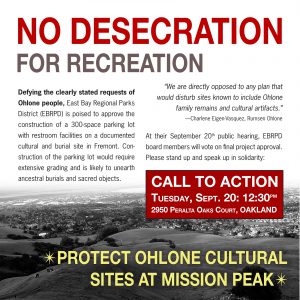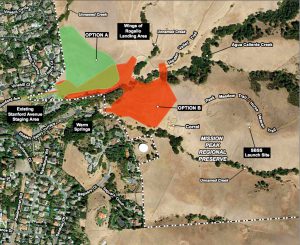Defying the clearly stated requests of Ohlone people, East Bay Regional Parks District (EBRPD) is poised to approve the construction of a 300-space parking lot with restroom facilities on a documented cultural and burial site in Fremont. Construction of the parking lot would require extensive grading to level the land and is likely to unearth ancestral burials and sacred objects.
At their September 20th public hearing in Oakland, EBRPD board members will vote on final project approval. Please stand with Ohlone people in solidarity:
CALL TO ACTION:
Tuesday, September 20, 2016: Meet 12:30pm @ 2950 Peralta Oaks Court, Oakland, CA
Let’s make it very clear to the board that the proposed project is unacceptable and the community is prepared to take additional action if necessary to ensure that Ohlone requests are honored.
Emails can also be sent to the Board of Directors:
wdotson@ebparks.org, blane@ebparks.org, dsiden@ebparks.org, awieskamp@ebparks.org, dburgis@ebparks.org, dwaespi@ebparks.org, jsutter@ebparks.org, bdoyle@ebparks.org
Excerpted commentary by Ohlone descendants regarding the project:
"We are sending this letter and petition (signed by 600 people) because we are directly opposed to any plan that would disturb sites known to include Ohlone family remains and cultural artifacts." —Charlene Eigen-Vasquez
“Enough is enough, no more digging up our ancestors’ human remains. We strongly oppose building parking lots on known archaeological sites at Mission Peak Regional Preserve.” —Barbara Lopez
“I’m really disappointed that they are going to put parking spaces on land that shouldn’t even be touched. It should be left the way it is. You should find another place to put your parking spots at. To us, Mission Peak is a sacred place.” —Ruth Orta
“The most egregious aspect of the entire project is that these immediate sites are known to have a very high probability of remains within them, as they have been found in the area previously. There is no ‘mitigation’ conceivable, nor permission by any entity, whether governmental (at any level), nor descendant individual, or group, that can justify the proposal that will likely lead to ancestral disturbances. Nor is it supported by law or preservation ‘ethics.’" —Gregg Castro
“Please note that these cultural sites cannot be cleansed when they are contaminated, nor do they replenish themselves when destroyed.…These sites must be treated with respect beyond the mitigations outlined in the EIR. These sites must remain undisturbed… Please do not continue with these proposed options and do not ratify the EIR.” —Alfonso Ramirez
"I’ve seen what people do to our ancestors and the land. They take mountains and flatten them to build houses. They take the creeks and move them wherever they feel like moving them. They bulldoze through our ancestors bones. Please, we beg you not to do this at Mission Peak. For the world to continue, this type of destruction must end. You say you will follow the law, and we believe that. But unfortunately, the law has never been on our ancestors’ side. The law may say that it’s OK for you to recover "scientific data" from our bones and artifacts, but it’s not OK with us." —Ramona Garibay
“I am not in favor of any digging or excavating. I am against the proposal for the 300 car parking lot. We need to protect our native cultural site as an Ohlone descendant I am asking that you please do not disturb that site.” —Sabrina Garibay
Additional information
The Environmental Impact Report (EIR) for EBRPD’s Stanford Avenue Staging Area Expansion Project outlines two potential project locations— both are within the boundaries of a documented cultural site, along Agua Caliente Creek at the base of Mission Peak. The stated purpose of the project is to "better accommodate park visitor demand for trail access from the existing Stanford Avenue Staging Area at Mission Peak Regional Preserve."
Mission Peak has seen a huge increase in trail usage in recent years, leading to an ongoing debate about the issue of parking. Although there is far more than ample parking in the surrounding neighborhoods and the parking lots of nearby Ohlone College, EBRPD is intent on expanding parking and facilities within Mission Peak Regional Preserve boundaries.
EBRPD’s EIR acknowledges that "the project could have a potentially significant impact on Native American archaeological deposits and human remains," yet claims that proposed mitigation measures reduce these impacts to a "less-than-significant" level. These so-called mitigations consist of "data recovery" and consultation with Ohlone descendants to develop a "Treatment Plan" for how human remains and cultural artifacts will be handled once unearthed. Data recovery simply means that all cultural materials will be excavated, documented and analyzed by a certified archaeologist prior to the site being destroyed.
"Data recovery, in consultation with members of the descendant community, provides a means of respecting Ohlone perspectives to the greatest degree possible while implementing the proposed project," the EIR states. At no point in this process do Ohlone people have the ability to stop or modify the project itself. In other words, the only option provided to Ohlone people within this plan is to help oversee and facilitate the destruction of their own sacred site.
Under the California Environmental Quality Act, preservation in place is the "preferred manner of mitigating impacts to archaeological sites," which sometimes entails capping sites with imported soils before construction occurs. In this case, EBRPD’s EIR states that "capping would not be feasible because the project site is not level and would require extensive grading and excavation (ground disturbance would result in approximately 12,000 cubic yards of cut, 2,000 cubic yards of which would be off-hauled)… Nor are any of the other methods of preservation in place feasible. The project could not feasibly be constructed so as avoid the historical resource CA-ALA-431 [the cultural site]. Similarly, incorporating the site of the historical resource within open space or placing the site under conservation easement would not achieve any of the project objectives and is thus also infeasible."
Links for further investigation:
- PDF link: Comment letters from Ohlone people and EBRPD responses, part 1
- 2015 Petition by the Confederation of Ohlone Peoples
- PDF link: Responses to Comments Document, August 2016
- PDF link: Draft Environmental Impact Report
- EBRPD Stanford Avenue Staging Area Expansion Project landing page (with links to associated documents):
- UN Declaration on the Rights of Indigenous Peoples (see articles 11, 12, & 25)





